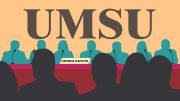One of UMSU president Jakob Sanderson’s chief goals is to see the U of M expand the use of open educational resources (OERs) in courses.
Last week, UMSU hosted an open educational resource fair to give students and faculty the chance to see some of the materials directly.
“What we are doing this week is getting the books right in front of students,” said Sanderson.
“People can see them, people can touch them, people can interact with them, and I think it can resonate a lot more easily.”
Open educational resources are free, downloadable learning materials developed in place of traditionally published textbooks to help save students money.
The texts are produced by experts and are peer-reviewed, but remain in the public domain and outside copyright controls.
“I think this is something that all government, university and faculty needs to take super seriously,” Sanderson said.
“I think it’s the next frontier in education in terms of something that’s innovative and really, really helps improve student performance and student affordability.”
Sanderson noted that the texts are completely adaptable and rather than having students purchase a new textbook for each new edition, the existing online materials can be easily updated.
The books may also be printed at a significantly lower cost to students, who only have to cover actual printing costs, said Sanderson.
UMSU is working closely with the Manitoba Open Textbook Initiative of Campus Manitoba — a consortium of publicly funded colleges and universities that works to expand access to post-secondary programs — to spread awareness of OERs through the university’s students, faculty and administration.
Sanderson outlined a four-tiered plan to bring the materials into more U of M classrooms, which includes placing open resources on the student agenda, introducing the materials to the faculty and working to address its concerns, striking a working group within the university’s administration to develop a three- to five-year action plan toward adopting the materials, and lobbying the government to establish grants to support the creation and adaption of open materials.
The Manitoba Open Textbook Initiative was launched in 2015 and a recently published report estimates that Manitoba students have saved more than $1 million in textbook costs.
Dylan Woodcock, an associate with Campus Manitoba, said the benefits of open materials are shared between faculty and students.
“The biggest benefit to OERs for students is that they represent a dramatic cost reduction compared to traditional and commercially published texts,” he said.
“The biggest benefit to faculty is that they are adaptable because they are under that open licence, so faculty can tweak them to the specifics of their course schedules.”
The movement is starting to gain traction on a national and international level.
According to Campus Manitoba, students in British Columbia have saved more than $12 million through OER programming. Students in Ontario saved more than $5 million and students in Saskatchewan more than $1.1 million.
So far at the U of M, open resources have been implemented in the department of computer science and first-year courses in other departments.
Woodcock said Campus Manitoba had set an initial goal to see Manitoba students save more than $1 million by 2020. With that benchmark already eclipsed, he said the potential for OER is limitless.
“There is never going to be a hard end goal because that amount of student savings can always keep increasing year after year after year,” he said.
“More and more open texts are being created and added to the repository, so it’s not ever something that can really end.”





